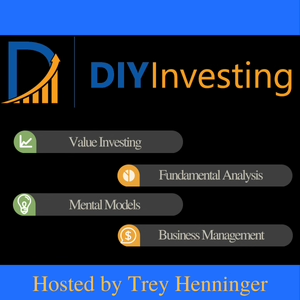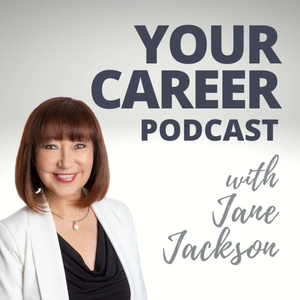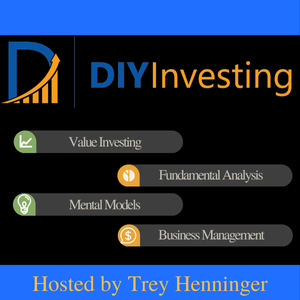
79 - How Banks Make Money
06/08/20 • 39 min
- Leverage
- Fractional Reserve Banking
- Margin
- Economies of Scale
- Operational Leverage
If you enjoyed this podcast and found it helpful, please consider leaving me a rating and review. Your feedback helps me to improve the podcast and grow the show's audience.
Follow me on Twitter and YouTubeTwitter Handle: @TreyHenninger
YouTube Channel: DIY Investing
Support the Podcast on PatreonThis is a podcast supported by listeners like you. If you’d like to support this podcast and help me to continue creating great investing content, please consider becoming a Patron at DIYInvesting.org/Patron.
You can find out more information by listening to episode 11 of this podcast.
Show OutlineThe full show notes for this episode are available at https://www.diyinvesting.org/Episode79
Banking Business Model - Key ConceptsAs some of you may remember, one of my goals for this year is to improve my understanding of bank stocks. Today’s podcast will focus on the basic business model that banks use to make money.
Key Concepts:
- Deposits
- Cost of Deposits
- Direct Cost: Interest Rates paid on Deposits
- Indirect Cost: Overhead (Employees, Rent, etc...)
- Loan Yields
- Loan Losses
- Fractional Reserve Banking -> Leverage Rate
- ROE = ROA * Leverage
- Banking Profits = Loan Yields - Loan Losses - Cost of Deposits - Overhead
- Recently watched: The Banker on Apple TV+
- Two black entrepreneurs in the 1960s buy two Texas banks.
- Samuel L. Jackson
- Anthony Mackie
The movie follows their journey and the ensuing blowback by Jim Crow.
One of the things the movie did very well was to explain the basic banking business model. Banks are easiest to understand when you focus on single branch banks instead of large money center banks like JP Morgan or Wells Fargo.
Summary:Banking is the business of bringing in deposits and lending them out.
Banking is a perfect example of a capital intensive business. A bank cannot grow unless it receives capital in the form of deposits. Deposits are the lifeblood of a bank and only through healthy deposit growth can a bank sustainably grow loans and therefore profits.
- Leverage
- Fractional Reserve Banking
- Margin
- Economies of Scale
- Operational Leverage
If you enjoyed this podcast and found it helpful, please consider leaving me a rating and review. Your feedback helps me to improve the podcast and grow the show's audience.
Follow me on Twitter and YouTubeTwitter Handle: @TreyHenninger
YouTube Channel: DIY Investing
Support the Podcast on PatreonThis is a podcast supported by listeners like you. If you’d like to support this podcast and help me to continue creating great investing content, please consider becoming a Patron at DIYInvesting.org/Patron.
You can find out more information by listening to episode 11 of this podcast.
Show OutlineThe full show notes for this episode are available at https://www.diyinvesting.org/Episode79
Banking Business Model - Key ConceptsAs some of you may remember, one of my goals for this year is to improve my understanding of bank stocks. Today’s podcast will focus on the basic business model that banks use to make money.
Key Concepts:
- Deposits
- Cost of Deposits
- Direct Cost: Interest Rates paid on Deposits
- Indirect Cost: Overhead (Employees, Rent, etc...)
- Loan Yields
- Loan Losses
- Fractional Reserve Banking -> Leverage Rate
- ROE = ROA * Leverage
- Banking Profits = Loan Yields - Loan Losses - Cost of Deposits - Overhead
- Recently watched: The Banker on Apple TV+
- Two black entrepreneurs in the 1960s buy two Texas banks.
- Samuel L. Jackson
- Anthony Mackie
The movie follows their journey and the ensuing blowback by Jim Crow.
One of the things the movie did very well was to explain the basic banking business model. Banks are easiest to understand when you focus on single branch banks instead of large money center banks like JP Morgan or Wells Fargo.
Summary:Banking is the business of bringing in deposits and lending them out.
Banking is a perfect example of a capital intensive business. A bank cannot grow unless it receives capital in the form of deposits. Deposits are the lifeblood of a bank and only through healthy deposit growth can a bank sustainably grow loans and therefore profits.
Previous Episode
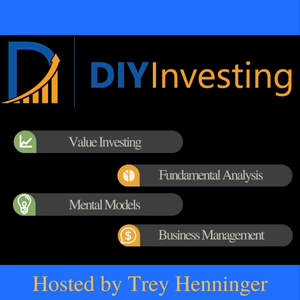
78 - Earnings Yield on Cost: A valuation rule of thumb
Mental Models discussed in this podcast:
- Earnings Yield
- Discount Rate
If you enjoyed this podcast and found it helpful, please consider leaving me a rating and review. Your feedback helps me to improve the podcast and grow the show's audience.
Follow me on Twitter and YouTubeTwitter Handle: @TreyHenninger
YouTube Channel: DIY Investing
Support the Podcast on PatreonThis is a podcast supported by listeners like you. If you’d like to support this podcast and help me to continue creating great investing content, please consider becoming a Patron at DIYInvesting.org/Patron.
You can find out more information by listening to episode 11 of this podcast.
Show OutlineThe full show notes for this episode are available at https://www.diyinvesting.org/Episode78
Earnings Yield on Cost- In our last episode, we discussed the source of investment returns. In this episode, we’ll dive deeper into the nuance of stock valuation.
- A rule of thumb is a simple reference point method to quickly determine whether a stock is overvalued or undervalued. A rule of thumb for valuation is not a substitute for valuation, but simply a starting point to allow you to focus and prioritize your time on ideas that appear to be good values.
- Earnings Yield - Current Earnings / Stock Price
- Earnings Yield on Cost: Possible Future Earnings / Original Stock Purchase Price
- Rule of thumb: Earnings yield on cost must eventually exceed 10% in order to earn a 10% rate of return on your investment (due to business performance) versus speculation.
Stocks must eventually trade at an earnings yield on cost equal to your discount rate in order to earn your required return on capital for you as an investor.
Stock Investing Examples- Amazon
- $1.22T Market Cap
- 2019 Earnings: $11.5B
- Earnings Yield: 0.9%
- Apple
- $1.38T Market Cap
- 2019 Earnings: $55B
- Earnings Yield: 3.9%
- Discover Financial
- $14.5B Market Cap:
- 2019 Earnings: $2.9B
- Earnings Yield: 20%
- NACCO
- $184m Market Cap
- 2019 Earnings: $39m
- Earnings Yield: 21.2%
Next Episode
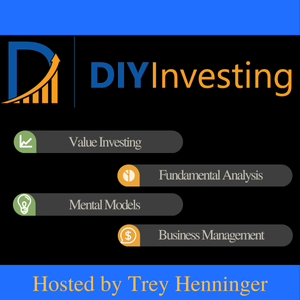
80 - Zero Interest Rates should not reduce your Discount Rate
Mental Models discussed in this podcast:
- Discount Rate
- Equity Risk Premium
- Second-Order Effects
If you enjoyed this podcast and found it helpful, please consider leaving me a rating and review. Your feedback helps me to improve the podcast and grow the show's audience.
Follow me on Twitter and YouTubeTwitter Handle: @TreyHenninger
YouTube Channel: DIY Investing
Support the Podcast on PatreonThis is a podcast supported by listeners like you. If you’d like to support this podcast and help me to continue creating great investing content, please consider becoming a Patron at DIYInvesting.org/Patron.
You can find out more information by listening to episode 11 of this podcast.
Show OutlineThe full show notes for this episode are available at https://www.diyinvesting.org/Episode80
Interest RatesI discuss The Fed and their recent actions to lower interest rates to zero using the overnight lending rate.
I also cover the equity risk premium and second-order effects of zero interest rates.
Discount Rates- Your Required Rate of Return
- Your need to save and invest can increase as rates fall
When the Fed reduces interest rates to zero the first-order effect is a disincentive to save. Yet, zero interest rates should not reduce your discount rate because the second-order effect is because lower returns would increase your need to save money.
If you like this episode you’ll love
Episode Comments
Generate a badge
Get a badge for your website that links back to this episode
<a href="https://goodpods.com/podcasts/the-diy-investing-podcast-15422/79-how-banks-make-money-7347231"> <img src="https://storage.googleapis.com/goodpods-images-bucket/badges/generic-badge-1.svg" alt="listen to 79 - how banks make money on goodpods" style="width: 225px" /> </a>
Copy
